Let me start with a confession: my first fiddle leaf fig lasted exactly three months. Three months of beautiful Instagram-worthy photos followed by a dramatic descent into brown-spotted, leaf-dropping chaos that left me questioning my entire identity as a plant parent. Sound familiar?
If you’re reading this with a struggling fiddle leaf fig nearby, frantically googling “why is my plant dying,” take a deep breath. You’re in excellent company.
Fiddle leaf figs have earned their reputation as the drama queens of the houseplant world, but here’s what I’ve learned after years of trial, error, and finally achieving success: they’re not actually trying to be difficult. They’re just very honest about their needs.
Think of your fiddle leaf fig as that friend who tells you exactly what they think—once you understand their language, the relationship becomes so much easier (and more rewarding).
Emergency Triage: Is Your Plant in Crisis?
Before we dive deep, let’s address the panic mode. If you’re here because your plant looks like it’s on death’s door, here’s your emergency checklist:
Immediate Action Required:
- Massive leaf drop (5+ leaves in a few days): Stop watering immediately, check for root rot
- Black or dark brown mushy spots: Remove from pot, inspect roots, trim any black/mushy parts
- All leaves drooping suddenly: Check soil moisture—either severely under or overwatered
- Visible pests: Isolate plant immediately, identify pest type, begin treatment
Can Wait a Few Days:
- Brown leaf tips: Usually humidity or watering schedule issue
- Small brown spots: Likely minor pest issue or bacterial infection
- One or two yellow leaves: Often normal aging, monitor for spread
- Slow growth: Environmental adjustment needed, not urgent
Now, let’s solve these problems step by step.
Part 1: The “Oh No!” Moments – Emergency Signals Decoded
The Great Leaf Drop Disaster
Nothing strikes fear into a plant parent’s heart quite like finding multiple leaves scattered around your fiddle leaf fig like fallen soldiers. I still remember discovering seven leaves on the floor one morning—I genuinely considered calling in sick to work for a “plant emergency.”
- What’s Really Happening: Your fiddle leaf fig is basically having a meltdown about something in its environment. Here’s how to decode the message:
- Gradual leaf drop (1-2 leaves over weeks): Usually normal aging of older, lower leaves. No panic needed.
- Sudden mass leaf drop: Environmental shock or watering extremes. This is your plant’s way of conserving energy when stressed.
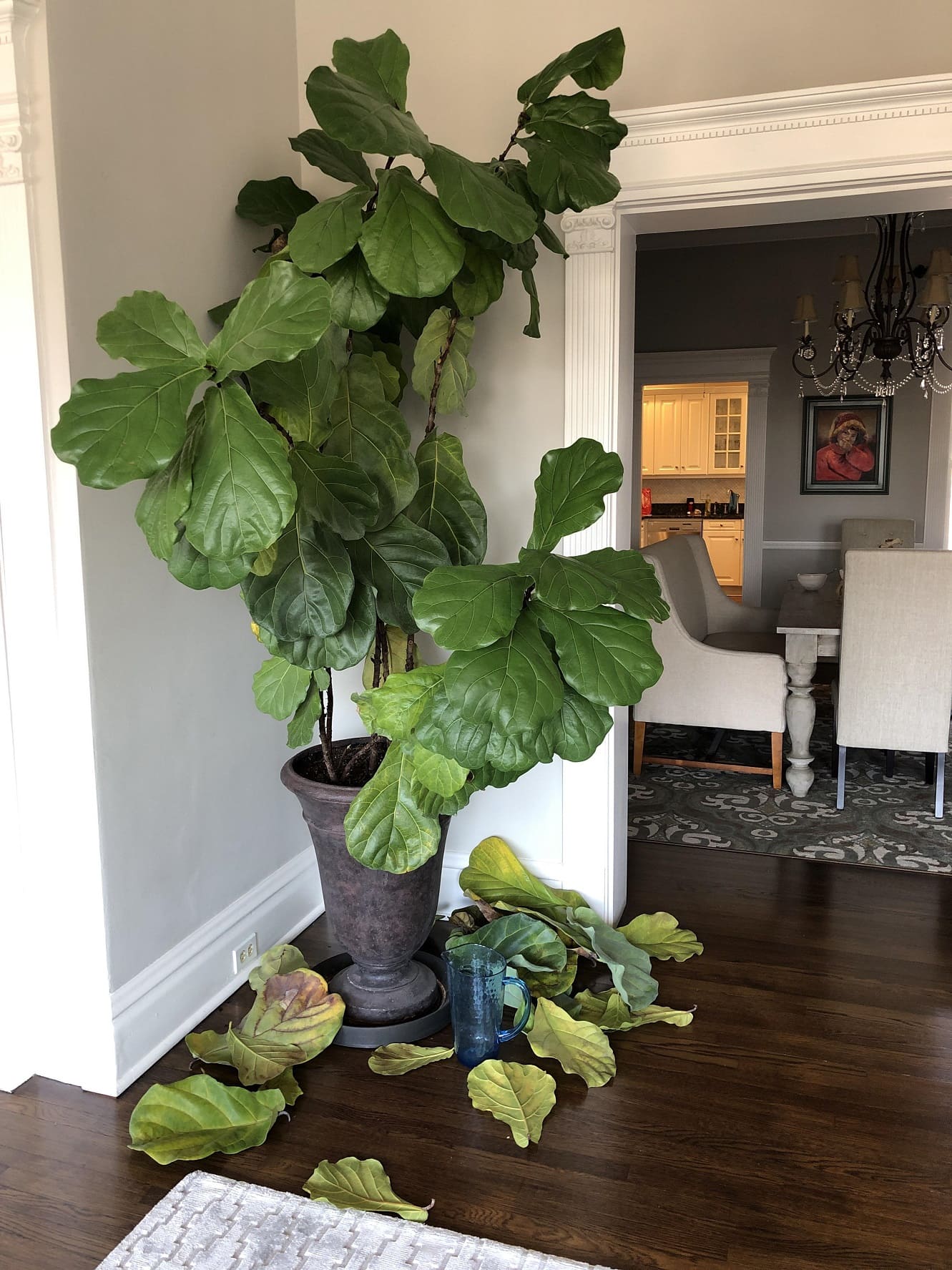
The Detective Work:
- Recent changes: Did you move, repot, or change its location?
- Seasonal shifts: Moving from warm to cool weather often triggers drop
- Watering extremes: Been extra generous or forgotten to water for weeks?
- Root investigation: If other causes don’t fit, check for root rot
The Recovery Plan:
- Stabilize immediately: Keep temperature, light, and location consistent
- Check soil moisture: Water only when top 2 inches feel dry
- Be patient: Recovery can take 4-6 weeks
- New growth is the goal: Focus on creating conditions for healthy new leaves
Recovery Timeline: With proper care, new growth typically appears in 4-8 weeks. Don’t expect dropped leaves to return—your focus should be on preventing further loss and encouraging new growth.
Find out Why You Should Leave Fall Leaves on Your Lawn and Garden
Brown and Black Spots: Reading Your Plant’s Medical Chart
Brown spots are like your plant’s way of showing you exactly what’s wrong. The location, size, and appearance tell the whole story.
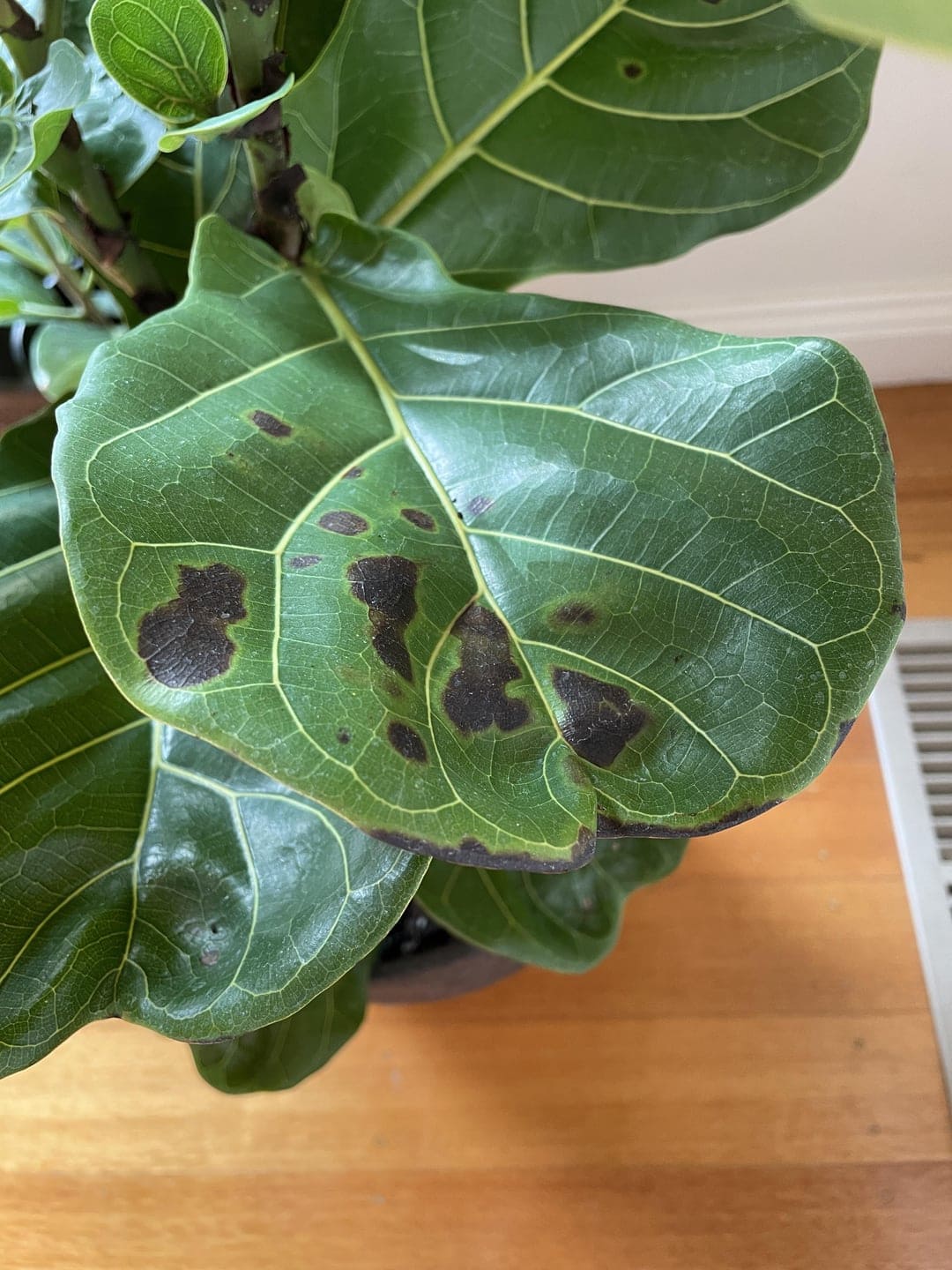
Small, Scattered Brown Spots = Pest Investigation Time
When I first discovered tiny brown spots on my fiddle leaf fig, I honestly thought it was just “character.” Wrong. Those little spots were actually spider mite damage, and they were having a feast on my plant’s sap.
Pest Identification Guide:
- Spider mites: Tiny brown spots with fine webbing between leaves and stems
- Scale insects: Brown bumps that look like they’re part of the plant (they’re not!)
- Thrips: Small brown spots that eventually become holes
Treatment Protocol:
- Isolate immediately (trust me, pests spread faster than gossip)
- Identify the culprit using a magnifying glass
- Choose your weapon: Insecticidal soap for general treatment, neem oil for prevention
- Treat weekly until no signs remain for two consecutive weeks
- Monitor closely for reinfection
Large, Irregular Brown Patches = Bacterial Leaf Spot
These look different from pest damage—larger, often with yellow halos, and they spread irregularly across the leaf surface. I learned this the hard way when I brought home a “bargain” plant from a nursery that turned out to be infected.
Treatment Approach:
- Remove affected leaves immediately with sterilized scissors
- Improve air circulation around the plant
- Reduce humidity slightly if it’s very high
- Consider copper-based fungicide for severe cases
- Monitor new growth for 4-6 weeks
Dark Brown to Black Spots = Root Rot Emergency
This is the big one. When spots are dark brown to black and appear mushy or wet, your plant’s roots are drowning. Time for emergency surgery.
Root Rot Rescue Mission:
- Remove from pot immediately
- Rinse roots gently to inspect damage
- Trim all black, mushy roots with sterilized tools
- Repot in fresh, well-draining soil
- Reduce watering dramatically until recovery signs appear
Recovery Timeline: Root rot recovery is slow—expect 6-12 weeks before seeing significant improvement. During this time, the plant may continue to drop leaves as it redirects energy to root recovery.
Here’s How to Identify and Fix Brown Spots on Your Snake Plant
Sunburn: When Your Plant Gets a Bad Tan
Those white or tan patches that appear suddenly? Your fiddle leaf fig got sunburned. It happened to mine when I enthusiastically moved it to a “brighter spot” without acclimating it first.
What Sunburn Looks Like:
- Bleached, white, or tan patches on leaves
- Usually affects leaves closest to the light source
- Patches feel papery or crispy to touch
- Often accompanied by leaf curling

Prevention and Treatment:
- Move gradually: When changing light conditions, do it over 1-2 weeks
- Use sheer curtains: Filter harsh direct sunlight
- Remove damaged leaves: They won’t recover and may become infection sites
- Monitor new growth: Should be normal once proper light levels are established
Find out Why Are My Cucumber Leaves Turning Yellow? Top Causes & Solutions
Part 2: The Subtle SOS Signals
Brown Leaf Tips: Your Plant’s Cry for Humidity
I learned about this one during my first winter with a fiddle leaf fig. As soon as the heating system kicked on, my beautiful plant started developing crispy brown edges like someone had taken a lighter to each leaf tip.

What’s Really Happening: Your plant is literally drying out from the edges inward. This happens when:
- Indoor humidity drops below 40% (common in heated homes)
- Consistent underwatering
- Proximity to heating vents or drafty areas
- Using water with high mineral content
The Humidity Solution:
- Humidifier: Most effective long-term solution (aim for 50-60% humidity)
- Pebble trays: Fill shallow trays with water and pebbles, place under pot
- Plant grouping: Cluster plants together to create humid microclimates
- Avoid misting: Can lead to fungal issues; focus on ambient humidity instead
Watering Adjustments:
- Check soil moisture more frequently during dry seasons
- Water quality matters—use filtered water if your tap water is very hard
- Ensure thorough watering when soil is dry to prevent salt buildup
Drooping and Curling: Your Plant Can’t Hold Itself Up
Drooping leaves are your fiddle leaf fig’s way of saying “I can’t maintain my structure anymore.” But here’s where it gets tricky—both overwatering and underwatering cause drooping, just for different reasons.
Underwatered Drooping:
- Soil feels dry throughout
- Leaves are limp but still green
- Plant perks up quickly after watering
- Often accompanied by brown leaf edges
Overwatered Drooping:
- Soil feels wet or soggy
- Leaves may be yellowing
- Plant doesn’t improve after watering
- May have musty smell from soil
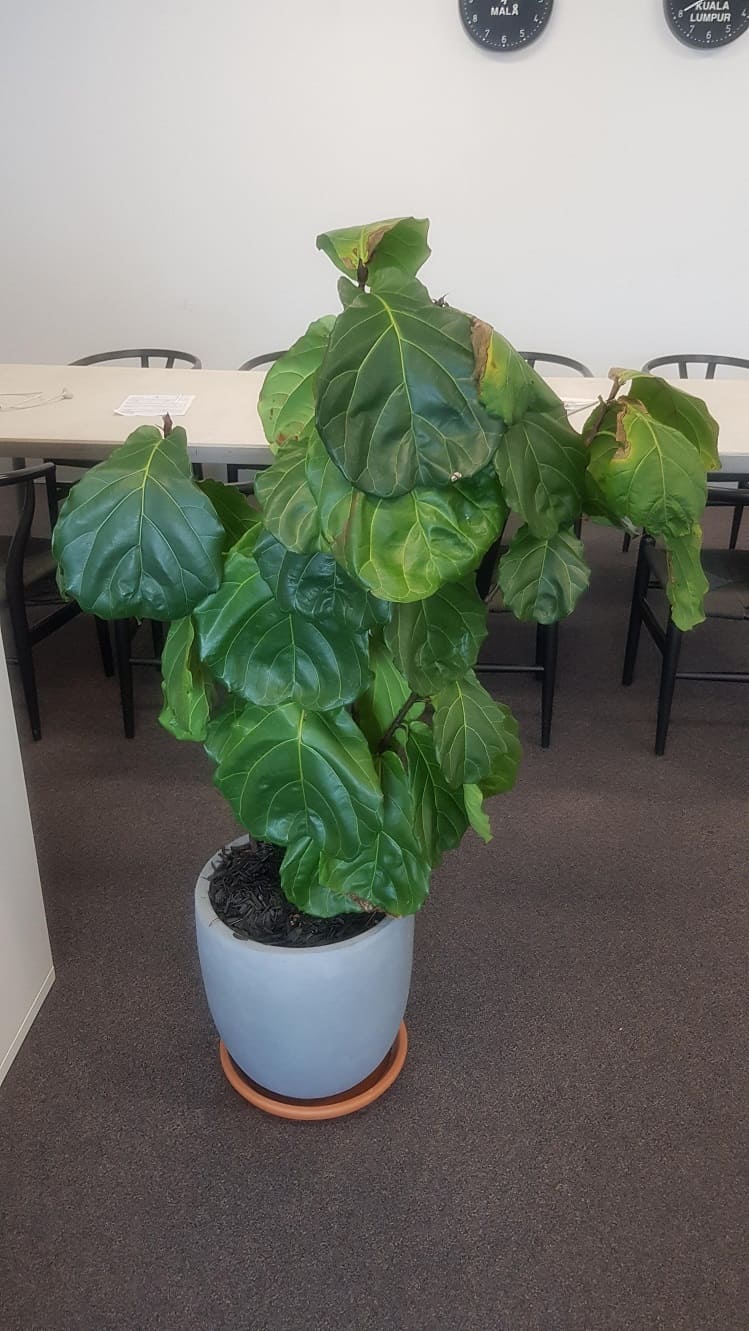
Leaf Curling Specifics: Curling is often your plant’s attempt to reduce surface area and conserve moisture. This can happen from:
- High light levels: Leaves curl to protect themselves
- Low humidity: Conserving internal moisture
- Inconsistent watering: Stress response to unpredictable conditions
Recovery Strategy:
- Assess soil moisture first (finger test 2 inches deep)
- Adjust watering accordingly
- Check environmental conditions (light, humidity, temperature)
- Be patient: Drooping can take 1-2 weeks to resolve even with proper care
Small New Growth: Your Plant is Energy-Starved
When your fiddle leaf fig produces tiny, pale leaves instead of those gorgeous large ones you see in magazines, it’s essentially saying “I’m doing my best with what you’ve given me, but I need more resources.”
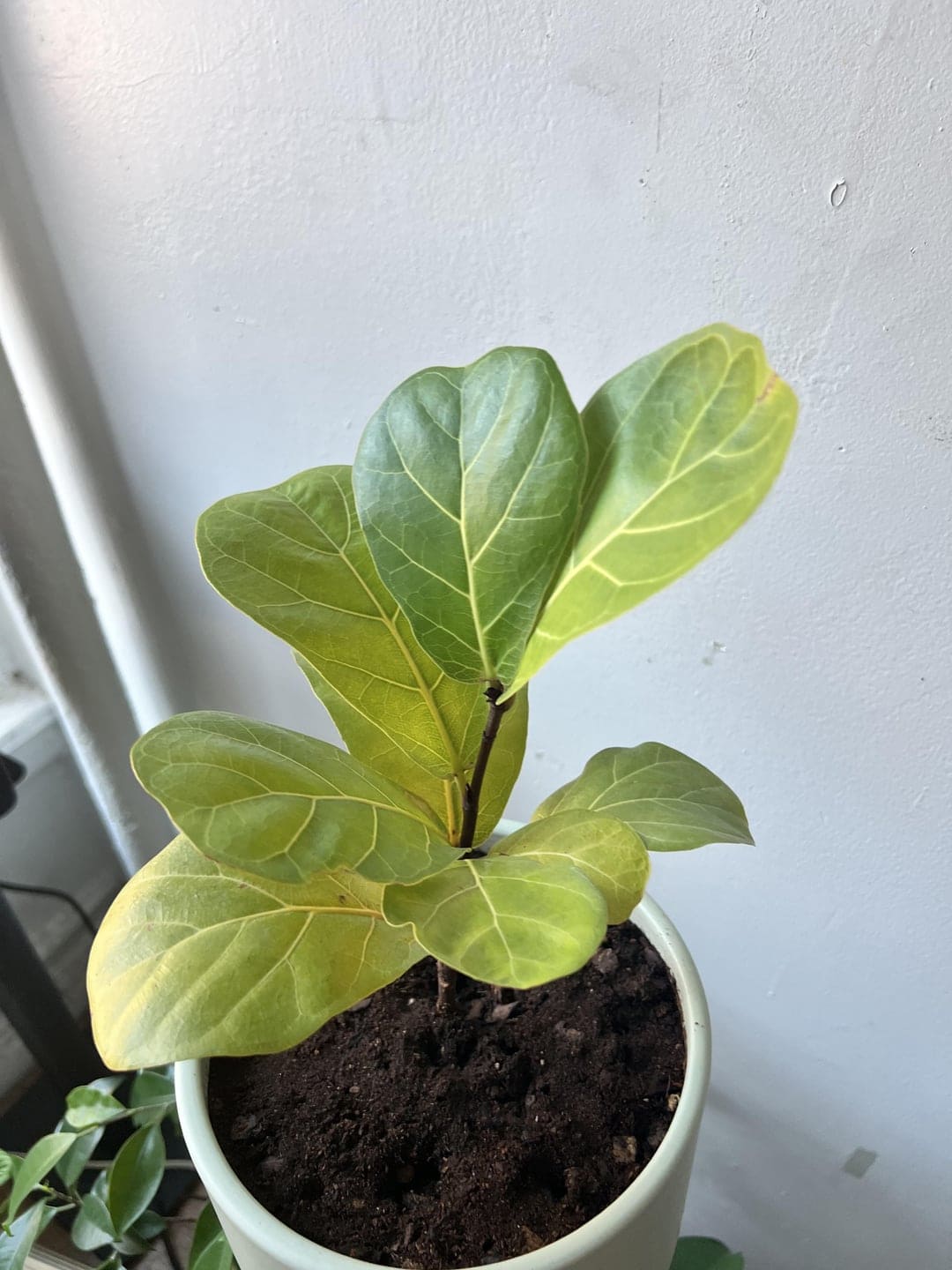
Common Causes:
- Insufficient light: Most common reason for small leaves
- Nutrient deficiency: Plant hasn’t been fertilized in months
- Root bound conditions: Not enough space for proper root development
- Seasonal dormancy: Normal in fall and winter
The Enhancement Plan:
- Light assessment: Move to brighter location gradually
- Fertilizer schedule: Monthly feeding during growing season (spring/summer)
- Root check: Look for roots growing from drainage holes
- Patience: New large leaves take 2-3 months to develop with improved conditions
Here’s How to Grow and Care for Pot Mums: A Comprehensive Guide
Red Spots: Your Plant’s Stress Response
Those tiny red dots that sometimes appear on new leaves? I call them your plant’s stress rash. The technical term is edema, and it happens when your plant absorbs more water than it can process, causing cells to burst.
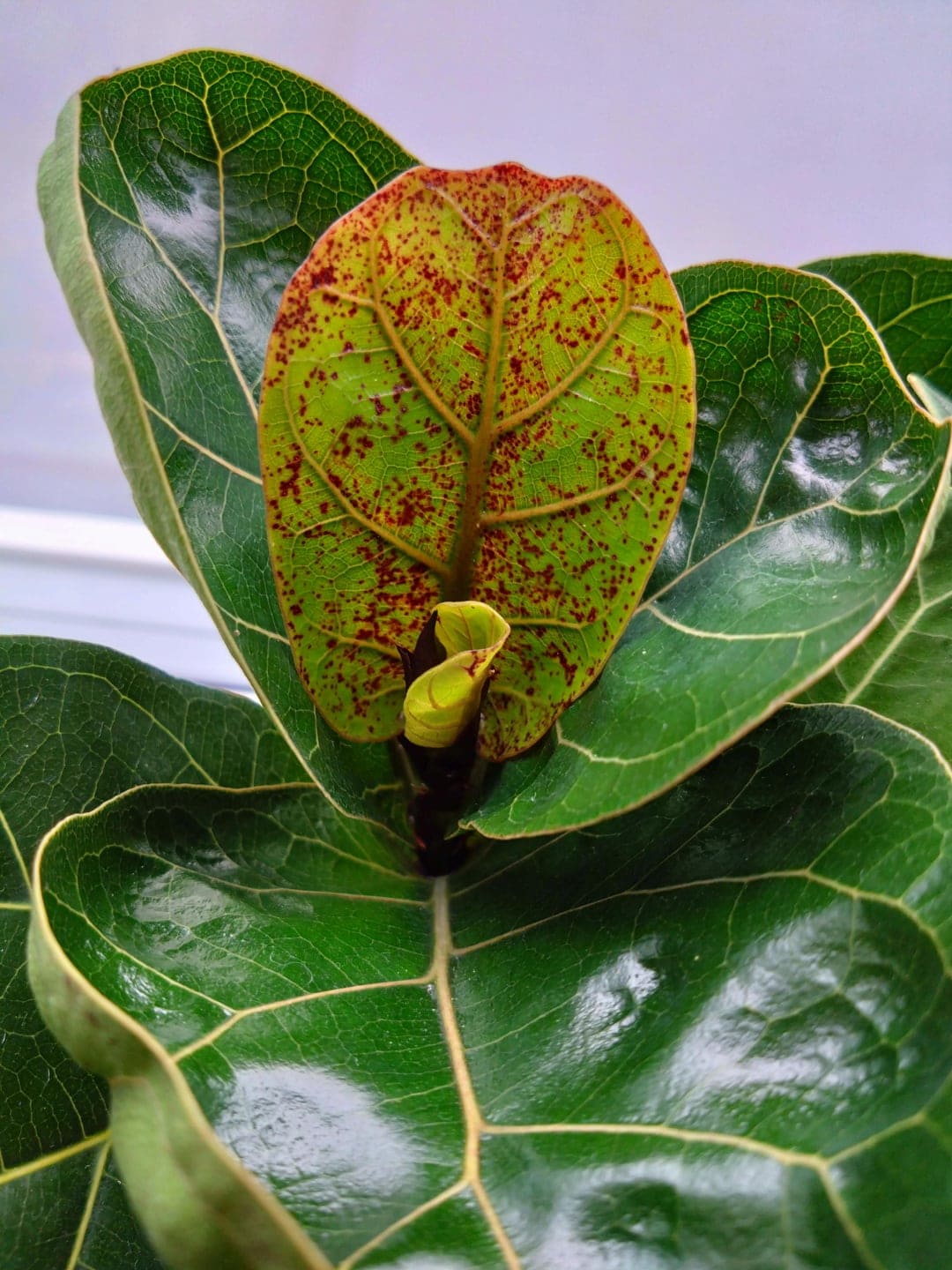
Why Edema Occurs:
- Inconsistent watering: Alternating between too dry and too wet
- High humidity with poor air circulation
- Temperature fluctuations
- Overwatering during cooler periods
Prevention and Management:
- Consistent watering schedule: Avoid extreme wet/dry cycles
- Improve air circulation: Use a small fan nearby
- Monitor seasonal changes: Adjust watering as growth slows in winter
- Don’t panic: Existing spots won’t disappear, but new growth should be normal
Part 3: The Uninvited Guests – Comprehensive Pest Management
Most Common Fiddle Leaf Fig Pests
1. Spider Mites: The Invisible Menace
These microscopic troublemakers love dry conditions and announce themselves with fine webbing and stippled yellow spots on leaves. I discovered my first infestation when I noticed what looked like tiny spider webs in the morning light.

Detection and Treatment:
- Early signs: Fine webbing, stippled leaves, tiny moving dots
- Treatment: Spray with water to remove, follow with insecticidal soap
- Prevention: Maintain humidity above 40%
2. Mealybugs: The Cotton Ball Invaders
Look like white cotton balls clustered in leaf joints and stem crevices. They’re plant vampires, literally sucking the life out of your fiddle leaf fig.

Combat Strategy:
- Spot treatment: Dab with rubbing alcohol on cotton swabs
- Systemic treatment: Insecticidal soap spray for large infestations
- Follow-up: Weekly inspections for 4-6 weeks
3. Scale Insects: Masters of Disguise
These brown, dome-shaped insects attach to stems and leaves, looking so much like part of the plant that they’re often missed until the infestation is severe.

Identification and Removal:
- Physical removal: Scrape off with fingernail or soft brush
- Chemical treatment: Systemic insecticide for heavy infestations
- Monitoring: Check weekly for several months
Integrated Pest Management Strategy
Prevention First:
- Quarantine new plants for 2-3 weeks before introducing to your collection
- Regular inspection during weekly care routine
- Maintain proper humidity (pests love dry conditions)
- Avoid overcrowding plants (improves air circulation)
Treatment Protocol:
- Isolate immediately upon detection
- Identify pest type accurately
- Remove manually when possible
- Apply appropriate treatment
- Monitor and repeat treatments as needed
- Gradual reintroduction to plant collection after 2 pest-free weeks
Learn To Master Natural Pest Control With Top Organic Solutions
Part 4: Environmental Mastery
Light: Finding the Goldilocks Zone
Fiddle leaf figs want bright, indirect light—bright enough to read a book comfortably, but not bright enough to get a suntan. Getting this right is often the difference between a thriving plant and a struggling one.
Ideal Light Conditions:
- East-facing windows: Perfect morning light without harsh afternoon sun
- South/west windows with protection: Sheer curtains or positioned 3-4 feet back
- North windows: Usually insufficient unless very large
- Artificial lighting: Full-spectrum grow lights 12-16 inches away
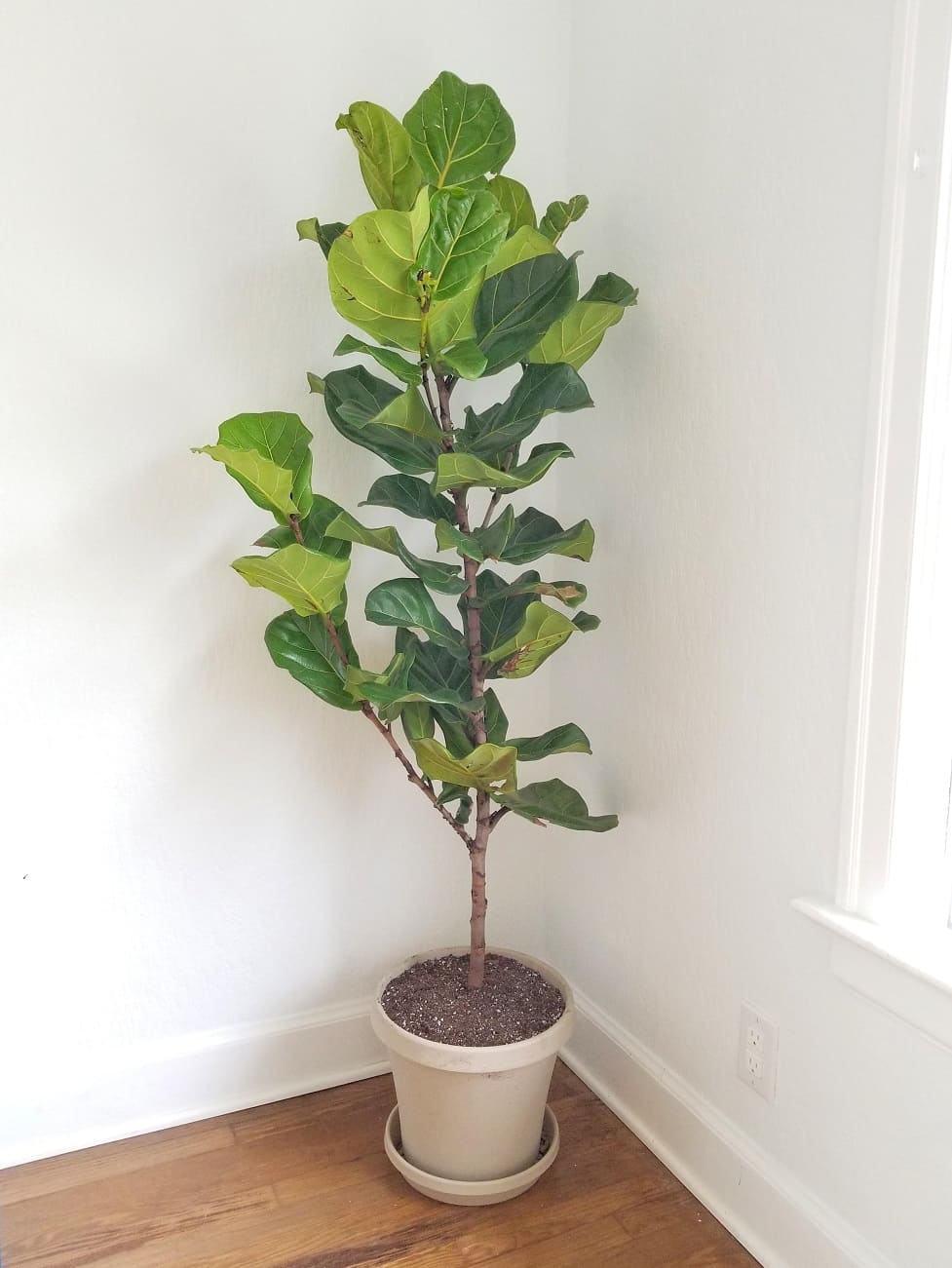
Troubleshooting Light Issues:
Too Much Light Signs:
- White or tan patches (sunburn)
- Leaves curling upward
- Rapid soil drying
- New leaves smaller than expected
Too Little Light Signs:
- Leggy growth with long spaces between leaves
- Small, pale new leaves
- Gradual leaf drop
- Leaning heavily toward light source
Light Optimization Tips:
- Rotate weekly: Quarter turn to ensure even growth
- Seasonal adjustments: May need to move closer to windows in winter
- Acclimate gradually: When increasing light, do it over 1-2 weeks
- Monitor new growth: Best indicator of proper light levels
Explore the Best Air-Purifying Indoor Plants That Thrive Without Direct Sunlight
Watering: The Make-or-Break Skill
This is where most fiddle leaf fig relationships go wrong. I used to water mine every Sunday religiously, regardless of what the plant actually needed. Terrible mistake.
The Golden Rules:
- Water by soil condition, not calendar
- Thorough watering when needed
- Excellent drainage is non-negotiable
- Seasonal adjustments are essential
Proper Watering Technique:
- Check soil moisture: Finger test 2 inches deep
- Water thoroughly: Until water runs out drainage holes
- Empty excess water: Remove from saucer after 30 minutes
- Wait for next cycle: Until top 2 inches dry again
Seasonal Watering Adjustments:
- Spring/Summer: More frequent watering as growth increases
- Fall/Winter: Reduce frequency as growth slows
- Heating season: May need more frequent watering due to dry air
- Dormant period: Water much less frequently but don’t let completely dry
Water Quality Considerations:
- Filtered water preferred: Especially if tap water is very hard
- Room temperature water: Avoid shocking roots with cold water
- Chlorine concerns: Let tap water sit 24 hours before using
Soil and Potting: The Foundation of Health
The right soil mix can prevent 80% of fiddle leaf fig problems. Your plant needs soil that drains well but retains some moisture—think “moist sponge, not swimming pool.”
Ideal Soil Composition:
- Base: High-quality potting mix (not garden soil)
- Drainage amendments: Perlite, coarse sand, or orchid bark
- Moisture retention: Small amount of peat moss or coconut coir
- pH level: Slightly acidic to neutral (6.0-7.0)
DIY Soil Mix Recipe:
- 60% quality potting soil
- 25% perlite or pumice
- 10% orchid bark
- 5% worm castings or compost
Potting Best Practices:
- Drainage holes mandatory: Multiple holes in bottom of pot
- Size matters: Pot diameter 2 inches larger than root ball
- Repotting schedule: Every 2-3 years or when rootbound
- Timing: Spring is ideal for repotting
Temperature and Humidity: Creating Paradise
Remember, fiddle leaf figs are from tropical West Africa. They’re happiest when you can replicate those warm, humid conditions.
Optimal Ranges:
- Temperature: 65-80°F (18-27°C)
- Humidity: 50-60% (most homes are 30-40%)
- Air circulation: Gentle movement, not drafts
Temperature Shock Prevention:
- Avoid cold drafts: Keep away from doors, windows in winter
- Heat source caution: Don’t place near radiators, heat vents
- Seasonal transitions: Gradual adjustment to changing conditions
- Travel considerations: Protect during transport in extreme weather
Humidity Enhancement Methods:
Most Effective:
- Room humidifier: Best long-term solution
- Pebble trays: Immediate area humidity boost
- Plant grouping: Creates humid microclimate
Less Effective but Helpful:
- Bathroom placement: If it gets enough light
- Kitchen location: Natural humidity from cooking
Avoid:
- Leaf misting: Can promote fungal issues
- Wet soil for humidity: Leads to root rot
Fertilizing: Feeding for Success
Proper nutrition transforms a surviving plant into a thriving one. But fiddle leaf figs are sensitive to overfertilizing, so less is often more.
Fertilizing Schedule:
- Growing season (spring/summer): Monthly feeding
- Dormant season (fall/winter): No fertilizing
- Newly repotted plants: Wait 6-8 weeks before fertilizing
Fertilizer Selection:
- Balanced liquid fertilizer: 10-10-10 or 20-20-20 NPK
- Dilution: Half-strength to prevent burn
- Organic options: Fish emulsion, worm casting tea
- Slow-release granules: Applied once per season
Signs of Fertilizer Problems:
Overfertilizing:
- Brown leaf edges despite proper watering
- White salt crust on soil surface
- Rapid growth followed by sudden decline
Underfertilizing:
- Pale, small new leaves
- Very slow growth during growing season
- Yellowing of older leaves
Part 5: Seasonal Care and Long-Term Success
Spring: The Wake-Up Call
As temperatures warm and days lengthen, your fiddle leaf fig starts preparing for its active growing season.
Spring Care Checklist:
- Gradually increase watering as soil dries faster
- Begin monthly fertilizing when new growth appears
- Repot if needed (every 2-3 years)
- Increase light gradually if moving to brighter location
- Inspect for winter damage and prune if necessary
Summer: Peak Growing Season
This is when your fiddle leaf fig should be putting on its best show with large, glossy new leaves.
Summer Priorities:
- Consistent watering schedule as plant actively grows
- Monitor for pests (they’re more active in warm weather)
- Maintain humidity despite air conditioning
- Regular fertilizing continues monthly
- Rotate weekly for even growth
Fall: Preparation Mode
As temperatures drop and light decreases, your plant starts preparing for its rest period.
Fall Adjustments:
- Reduce fertilizing and stop by November
- Decrease watering frequency as growth slows
- Increase humidity as heating systems start up
- Monitor for temperature stress from heating system
- Final pest inspection before dormant season
Here’s How to Turn Fall Leaves into Soil Enriching Mulch For a Nutrient-Rich Garden
Winter: Rest and Recovery
This is your plant’s dormant season. Growth slows dramatically, and care requirements change.
Winter Care Strategy:
- Minimal watering: Only when soil is quite dry
- No fertilizing: Plant isn’t actively growing
- Humidity focus: Combat dry indoor air
- Light optimization: May need to move closer to windows
- Temperature stability: Protect from cold drafts
Maintenance and Cleaning
Regular maintenance keeps your fiddle leaf fig looking its best and helps prevent problems.
Weekly Tasks:
- Soil moisture check: Finger test for watering needs
- Leaf inspection: Check for pests, damage, or problems
- Rotation: Quarter turn for even growth
- Dust removal: Quick wipe with damp cloth
Monthly Tasks:
- Deep cleaning: Thorough leaf wiping with damp cloth
- Fertilizing (during growing season)
- Detailed pest inspection: Check stems, undersides of leaves
- Growth assessment: Measure progress and adjust care
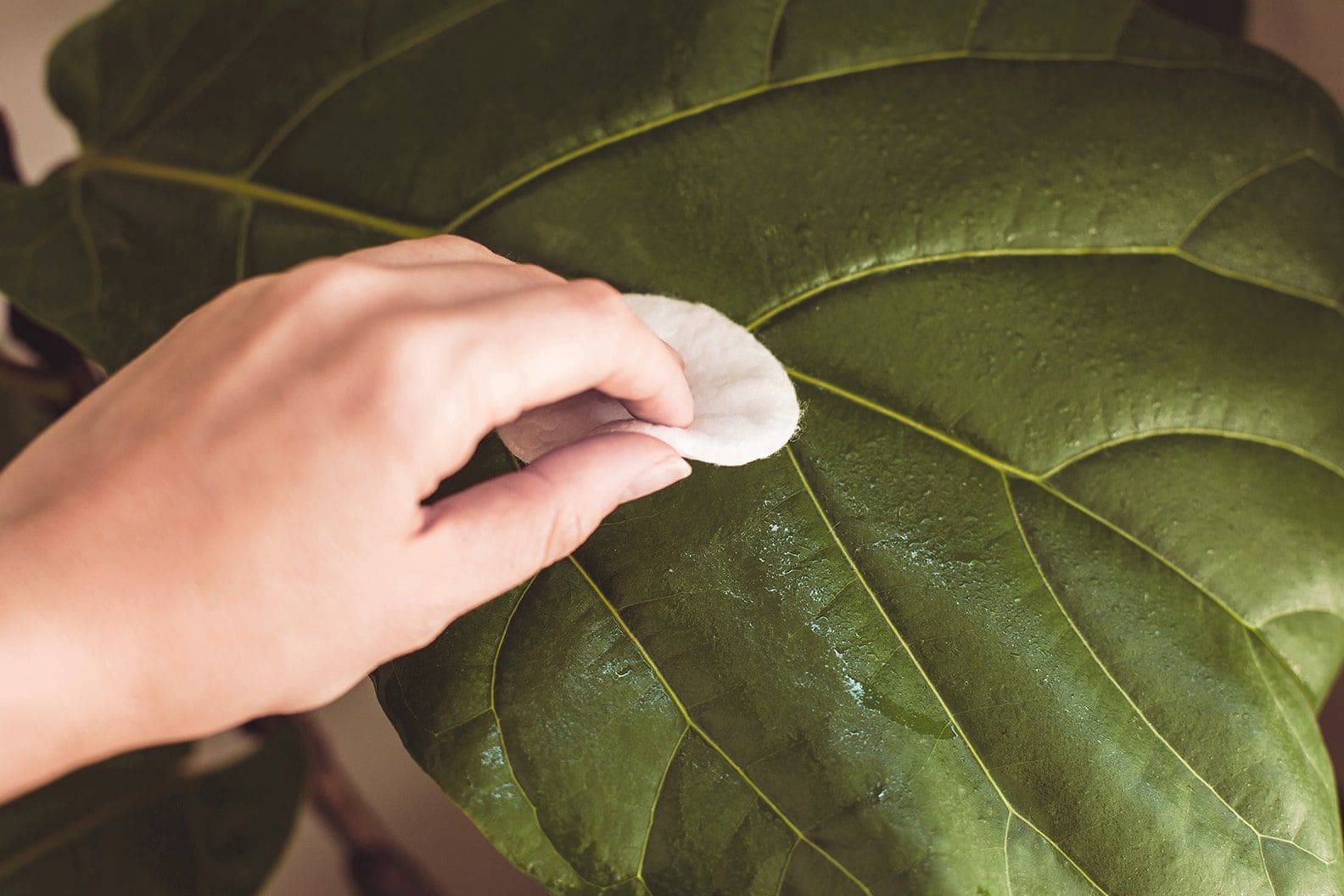
Seasonal Tasks:
- Repotting (spring, every 2-3 years)
- Pruning (late winter/early spring)
- Deep soil inspection for root health
- Care routine adjustments for seasonal changes
Part 6: Recovery, Propagation, and Advanced Care
Recovery Timelines: Managing Expectations
Understanding how long recovery takes helps you stay patient and avoid overcorrecting.
Typical Recovery Periods:
- Pest treatment: 2-4 weeks for complete elimination
- Root rot recovery: 6-12 weeks for new growth
- Environmental stress: 4-8 weeks for stability
- Nutritional deficiency: 6-10 weeks for improvement
- Light adjustment: 8-12 weeks for full adaptation
Recovery Signs to Watch For:
- New growth appearing: Best sign of successful treatment
- Existing leaves looking healthier: Color improvement, firmness
- Stable conditions: No further leaf drop or problem progression
- Root development: New white roots visible during repotting
Propagation: Growing Your Collection
Once you’ve mastered fiddle leaf fig care, propagation lets you expand your collection or share with friends.
Best Propagation Methods:
Stem Cuttings:
- Select healthy growth: 6-8 inches with 2-3 leaves
- Make clean cut: Just below a node with sterilized tools
- Rooting hormone optional: Can speed development
- Water propagation: Place in clean water, change weekly
- Soil transition: Plant when roots are 2-3 inches long
Air Layering:
- For larger branches: When you want to maintain parent plant
- Slower process: 6-12 months for full development
- Higher success rate: Roots develop while attached to parent
Propagation Timeline:
- Water roots: 4-8 weeks to develop
- Soil planting: When roots are 2-3 inches
- Establishment: 8-12 weeks in soil
- Normal care: Treat as mature plant after 6 months
Here’s How to Make Willow Water: The Best Natural Rooting Hormone
When to Seek Help or Give Up
Sometimes, despite our best efforts, a plant is beyond saving. Here’s how to know when you’ve reached that point.
Signs of Hope:
- Firm, green stems: Even if no leaves remain
- White sap when scratched: Indicates living tissue
- New growth buds: Small bumps along stems
- Healthy root system: Even if top is damaged
Signs It’s Time to Let Go:
- Completely black, mushy stems: No living tissue remaining
- No response after 3 months: Of proper care and treatment
- Extensive root rot: More than 75% of roots are black/mushy
- Repeated pest infestations: Despite proper treatment
Making the Decision:
- Propagation attempt: Take any healthy cuttings first
- Compost responsibility: Don’t spread diseases to other plants
- Learn from experience: What went wrong and how to prevent it
- Start fresh: Apply lessons learned to new plant
Emergency Quick Reference Guide
Immediate Problems and Solutions
Plant is dropping many leaves:
- Check soil moisture immediately
- If soggy: Stop watering, check for root rot
- If dry: Water thoroughly, establish consistent schedule
- Stabilize environment (temperature, light, location)
Brown/black spots appearing:
- Isolate plant from others
- Small spots: Check for pests with magnifying glass
- Large patches: Remove affected leaves, improve air circulation
- Black spots: Check roots immediately for rot
All leaves drooping suddenly:
- Check soil moisture first
- Assess recent environmental changes
- Look for pest damage
- If overwatered: Allow to dry, check roots
- If underwatered: Water thoroughly, monitor humidity
Visible pests:
- Isolate immediately
- Identify pest type
- Begin appropriate treatment (soap, neem oil, alcohol)
- Monitor daily and repeat treatment weekly
- Quarantine for 2 weeks after last pest sighting
Your Path to Fiddle Leaf Fig Success
Here’s what I want you to remember: every experienced plant parent has killed a fiddle leaf fig. It’s practically a rite of passage in the houseplant community. The difference between long-term success and repeated failure isn’t perfection—it’s learning to read your plant’s signals and responding appropriately.
My current fiddle leaf fig (I call her Fiona) has been with me for four years now. She’s tall, bushy, and absolutely gorgeous, but more importantly, I finally understand what she needs. When she drops a leaf, I investigate rather than panic.
When her leaves start looking dull, I check the humidity levels. When new growth comes in small, I assess the light situation and make gradual adjustments.
The relationship between you and your fiddle leaf fig is exactly that—a relationship. It requires time, attention, and mutual understanding. There will be setbacks, learning moments, and small victories along the way.
But when you finally get it right, when you walk into a room and see your thriving, glossy-leaved beauty reaching confidently toward the ceiling, you’ll understand why plant parents everywhere are willing to put up with the drama.
Your fiddle leaf fig isn’t trying to be difficult. It’s just waiting for you to learn its language. Once you understand what it’s telling you through its leaves, stems, and growth patterns, you’ll wonder why you ever found it challenging in the first place.
Be patient with yourself and your plant. Every brown spot is valuable information, every dropped leaf is a learning opportunity, and every new leaf is a small celebration. With the knowledge in this guide and consistent care, your fiddle leaf fig will transform from a source of stress into a source of pride and joy.
Remember: Consistency beats perfection every time. Your plant will forgive mistakes much more easily than neglect. Happy growing!
